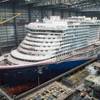Hapag-Lloyd on Ship Recycling Transparency Initiative
Ships are often disassembled on beaches by people who don’t wear any protective clothing or take any other safety precautions. One reason for this is that there still aren’t any globally agreed standards that shipping companies must adhere to, said a report by Hapag-Lloyd.
In 2017, 835 ships of the global fleet of 50,000 vessels were recycled – but in very different ways. In December 2018, the Ship Recycling Transparency Initiative (SRTI) launched an online platform to draw attention to these practices and, above all, to showcase examples of best practice.
The initiative aims to draw attention to the issue by increasing transparency and to thereby raise stakeholders’ awareness about recycling practices over the life cycle of a ship. In the long term, it is hoped that more shipping companies will eventually opt to recycle their vessels in an eco-friendly manner.
Hapag-Lloyd is one of the co-founders of the initiative along with other shipping companies, banks and classification societies. As early as May 2014, the company adopted an internal directive on ship recycling stipulating that ships which are no longer needed must be recycled in a safe and environmentally friendly manner. This means that all Hapag-Lloyd ships are recycled in shipyards in accordance with the highest environmental standards.
At present, the key issue related to eco-friendly ship recycling is the shipyards themselves, as there are too few of them in the EU states that are certified according to EU standards. However, before the EU Ship Recycling Regulation entered into force on 31 December 2018, the European Commission published a further update of the list of recognised recycling yards, which for the first time includes three yards outside the EU: two in Turkey and one in the United States.
In drawing up this list, the main factor taken into account was the total LDT (light displacement tonnes) capacity of all yards rather than the current dimensions of the yard docks. The problem here is that most of the shipyard docks on the list are too small and couldn’t even accommodate a 4,400 TEU ship. And to further complicate the situation, Chinese shipyards will only recycle ships under Chinese flag.
Thus, the extension of the list of recognised yards is an important step in the right direction – but not enough at this time. For this reason, it is a good thing that the European Commission is currently visiting progressive shipyards in India that are already certified by a leading classification society according to the 2009 Hong Kong Convention for the safe and environmentally sound recycling of ships. However, the final assessment of the EU member states is still pending.
“We are active in a global business, so shipyards outside the EU that have invested in occupational safety and environmental protection should also be taken into consideration”, says Wolfram Guntermann, Director of Environmental Management at Hapag-Lloyd. “Hapag-Lloyd supports the European Community Shipowners’ Association (ECSA) and the International Chamber of Shipping (ICS) in their efforts to set limits on special regional rules and to promote rapid ratification of the Hong Kong Convention. So we are also pleased that Germany has now decided to ratify it.”
The SRTI intends to make sure that the issue of ship recycling receives more public attention. The aim is to create a level playing field across the industry so that all shipping companies will one day choose to recycle their ships in an environmentally sound manner.














